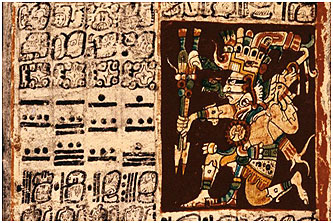 HOME| THE STORY | THE PRODUCTION | ABOUT THE MAYA SCRIPT |SCREENINGS |REVIEWS | PRESS KIT | INTERVIEW ARCHIVES | RESOURCES | SPONSORS
HOME| THE STORY | THE PRODUCTION | ABOUT THE MAYA SCRIPT |SCREENINGS |REVIEWS | PRESS KIT | INTERVIEW ARCHIVES | RESOURCES | SPONSORS

A hieroglyphic tablet from the site of Toniná
(photo © Justin Kerr).
The Maya writing system was used in what is now Mexico and Central America for almost two thousand years, until after the arrival of Cortés. It was written in bark paper books, carved on public monuments and inscribed on personal objects of pottery, bone and jade. ![]()
 The invading Spanish outlawed the script and burned thousands of books, systematically wiping out literacy in the Maya script and severing the Maya people from the written record of their own extraordinary past.
The invading Spanish outlawed the script and burned thousands of books, systematically wiping out literacy in the Maya script and severing the Maya people from the written record of their own extraordinary past. ![]()

In the nineteenth century the texts began to re-emerge, as buried cities and fantastic inscriptions were discovered in the jungles and rare Maya books plundered by the Spanish were re-discovered in the libraries of Europe. Early scholars decoded the complex Maya calendar and identified glyphs for gods, planets, animals, colors and directions. But prejudice and misconceptions about the nature of the Maya people and their script kept the meaning of the texts a mystery for over a century more. ![]()

Ian Graham (right), Director of Harvard’s Maya Corpus Project, shows film director David Lebrun his drawing of a Maya inscription.
Over the past few decades, a diverse group of epigraphers and historians, ethnographers and archaeologists, astronomers and linguists, artists and amateurs, have finally unlocked the secrets of the glyphs. Today over ninety percent of the script is understood.
![]() For the six million modern day Maya, this recovered history, poetry and mythology is an extraordinary source of pride and identity. Maya students are now learning to read hieroglyphs, and parents who for centuries named their babies after Christian saints are now naming their children after ancient Maya kings.
For the six million modern day Maya, this recovered history, poetry and mythology is an extraordinary source of pride and identity. Maya students are now learning to read hieroglyphs, and parents who for centuries named their babies after Christian saints are now naming their children after ancient Maya kings.

Seat back of a carved throne from Piedras Negras, now in the Guatemala National Museum of Archeology and Ethnology.